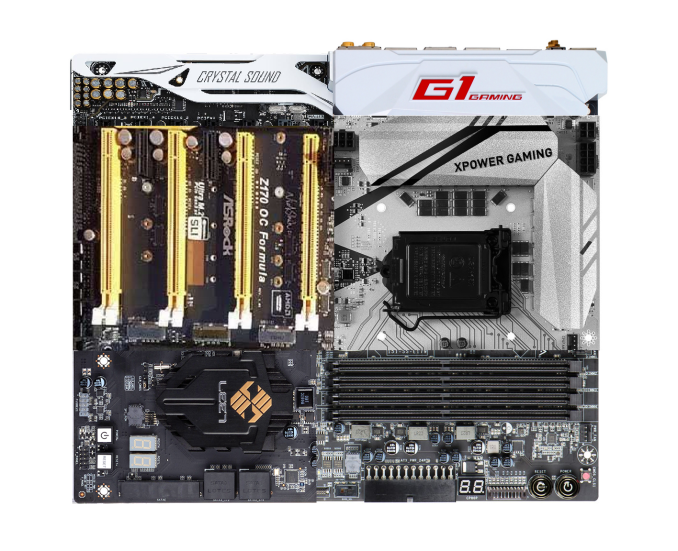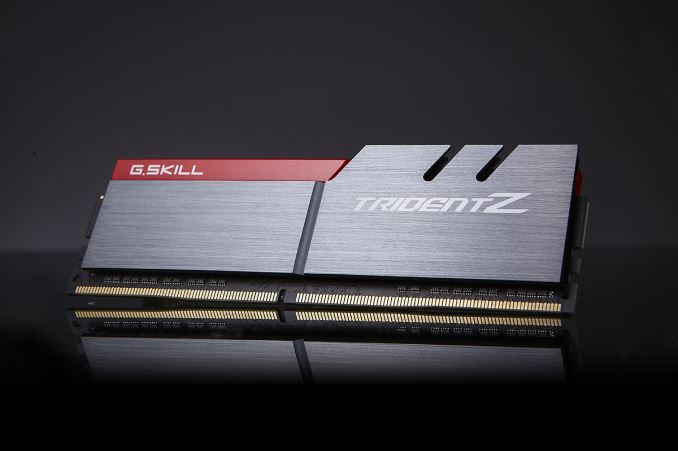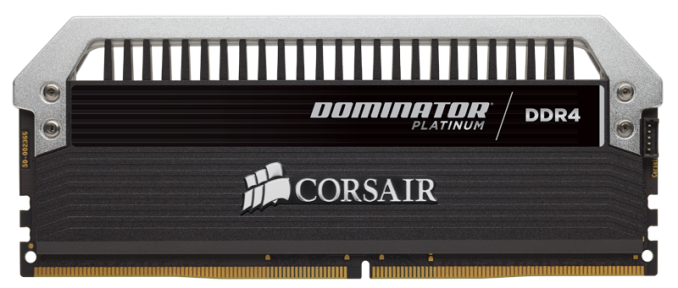The Intel 6th Gen Skylake Review: Core i7-6700K and i5-6600K Tested
by Ian Cutress on August 5, 2015 8:00 AM ESTAlso Launching Today: Z170 Motherboards, Dual Channel DDR4 Kits
The new Skylake processors are assigned a new socket – LGA1151. Intel’s policy since 2006 has been to maintain sockets for two generations and as a result moving from Broadwell to Skylake we were expecting the change. This means that Skylake processors will not work in LGA1150 based motherboards, i.e. those with Intel’s 8th and 9th generation chipsets. For Skylake we get the 100-series chipsets with additional functionality. Launching today in turn is the first member of the 100-series family, the overclocking-friendly Z170, with the other chipsets in the family to follow later in the year.
We have a large piece on the motherboards being released or talked about for Skylake, covering some 55+ products and the different variations within. The major motherboard manufacturers such as ASUS, GIGABYTE, ASRock, MSI, EVGA and a couple of others should all have a wide range ready to purchase on day one, although some models may be region specific.

The badly MSPaint’ed hybrid: MSI’s XPower Gaming Socket, GIGABYTE’s G1 Gaming IO panel, EVGA’s DRAM slots, ECS’s chipset, ASRock’s PCIe arrangement and ASUS’ Deluxe audio.
Here’s an amalgamation of some of the designs coming to end users, with almost all of them investing heavily in gaming brands with specific components to aid the user experience while gaming. Aesthetic designs are also going to be a focus of this generation, with some of the manufacturers moving into a different direction with their designs and trying some new color schemes. Some basic looking models will also be available.
Prices for Z170 motherboards will range from $80 all the way past $400+, depending on feature set and size. A number of motherboards above $150 will feature a couple USB 3.1 Gen 2 (10Gbps) ports, although you will have to check whether they are Type-A or Type-C. That being said, most motherboards with USB 3.1 will use both, but there are a select few that are C-only or A-only. Also over $150 we will see a lot of Intel’s new network controller, the I219-V, although the gaming lines might invest in Rivet Network’s Killer solution instead.
Intel is launching the Alpine Ridge controller at this time as well, which is said to support USB 3.1 Gen 2, Thunderbolt 3, HDMI 2.0, DisplayPort, and DockPort. According to our sources it would seem that GIGABYTE currently has an exclusive on this technology, and it will be used for their USB 3.1 Gen 2 ports on most motherboard models. Other functionality from the Alpine Ridge controller (TB3, HDMI 2.0) will be on a case-by-case basis depending on how the controller works in two different modes or if extra components are used. We are told that Alpine Ridge costs similarly to the ASMedia ASM1142 controller, but will enable two USB 3.1 Gen 2 ports at 10 Gbps simultaneously as it uses four PCIe lanes from the chipset.
We will go more into the 100-series chipset in the next page, but it is worth mentioning briefly here that the speed between the CPU and the chipset has increased from DMI 2.0 (5 GT/s, 2GB/sec) to DMI 3.0 (8 GT/s, 3.93GB/sec), and that the chipset has a new high speed hub (HSIO) that allows 26 lanes to be used from it although some lanes are limited (e.g. 20 PCIe 3.0 lanes maximum split into five x4 controllers). Intel’s Rapid Storage Technology is upgraded as well to give three PCIe drives access to its features as long as they are on the correct HSIO ports.
DRAM: The March to DDR4
In the world of DRAM for personal computers, DDR3 is currently king. Having been the main standard since 2007, you would be hard pressed to find a mainstream or low end platform sold that did not require access to DDR3. That changed in the enthusiast segment last year with the launch of Haswell-E which also introduced DDR4 at a high premium. For Haswell-E there was no crossover – you had no choice but to use DDR4 (unless you might be a million-unit customer).
Because the consumers and consumer product OEMs are more price sensitive, DDR4 will be a slower transition. There is precedent here in that the move from DDR2 to DDR3 saw a generation of processors that supported both standards and it was up to the motherboard manufacturer to design for it. In this transition, Skylake processors will support both DDR3L and DDR4 modules, with a few caveats.
Caveat number one is that initially, only DDR4 motherboards will be on the market. So if you upgrade now, DDR4 needs to be on the shopping list as well. We have had word of some DDR3L-only motherboards coming, as well as combo boards with DDR3L and DDR4 slots on board. Caveat one-point-five, you can use either DDR3L or DDR4, but not both at the same time.
Caveat number two, DDR3L is different to DDR3 as it operates at a lower voltage. This means that the memory controllers on Skylake most likely have a combined voltage domain, and regular DDR3 might not work (in fact early testing suggests not without reducing the voltage). Very few people currently own DDR3L DIMMs, so the likelihood of a user performing an upgrade while reusing their RAM might be slim.
Caveat number three: prices of DDR4 have dropped significantly since last year, and there is only a small premium over DDR3. The benefits of DDR4 include a lower operating voltage, a more stable design, and the ability to purchase 16GB modules with ease. That means that a Skylake platform will happily take 64GB of memory.
With that last point, we should point out that Skylake is a dual memory channel architecture, supporting two memory modules per channel. This gives a maximum of four DDR4 tests, and 4x16 = 64GB maximum.
We have been told that Skylake’s memory controller, compared to previous generations, is absolutely golden at higher speed memory support. By default Skylake supports the JEDEC standard for DDR4, 2133 MT/s at a latency of 15-15-15, but the overclocking guides we have received suggests that all processors should be able to reach DDR4-3200 relatively comfortably, with a few processors in the right motherboards going for DDR4-4000. While this should bode well for integrated graphics users, those high end kits are typically very expensive.
We currently have dual channel kits in to test from a number of the DRAM companies, and plan on performing a memory scaling article within the next few weeks to see how exactly performance might scale on Skylake. Though in the meantime, as part of this review, we were able to source a closed beta variant of a combination DDR3L/DDR4 motherboard for Skylake and have included a test comparing the two.












477 Comments
View All Comments
medi03 - Thursday, August 6, 2015 - link
Yeah. Blaming Intel that HP didn't want to use FASTER AMD CPUs FOR FREE, fearing Intel's illegal revenge is just nuts.AMD Athlon 64's beat Intel in all regards, they were faster, cheaper and less power hungry. Yet Intel was selling several times more Prescotts,
Not being able to profit even in a situation when you have superior product (despite much modest R&D budget), yeah, why blame intel.
MrBungle123 - Sunday, August 9, 2015 - link
In the Athlon 64 days, yes, AMD had a better product but the cold hard truth behind the curtain was that AMD didn't have the manufacturing capacity to supply everyone that Intel was feeding chips to.silverblue - Thursday, August 6, 2015 - link
A "tweaked 8-core Ph2"? Putting aside the fact that significant changes would've been required to the fetch and retire hardware (the integer units themselves were very capable but were underutilised), a better IMC and all the modern instruction sets that K10 didn't support, AMD had already developed its replacement. It probably would've buried them to have to shelve Bulldozer (twice, it turns out) and redevelop what was essentially a 12-year old micro-architecture.AMD were under pressure to deliver Bulldozer hence the cutting of corners and the decision to go with GF's poor 32nm process as they simply didn't have any alternative (plus I imagine they were promised far more than GF could deliver). Phenom II was not enough against Nehalem, let alone Sandy Bridge.
Blaming Intel doesn't help either as AMD couldn't exactly saturate the market with their products even when they were fabbing them themselves, however I think the huge drop in mainstream CPU prices when Core 2 was released along with the huge price paid for ATi did more damage than any bribing of retailers and systems manufacturers.
nikaldro - Wednesday, August 5, 2015 - link
40% over excavator, with 8 cores, good clockspeeds and good pricing doesn't sound that bad. I'll wait till Zen comes out, then decide.Spoelie - Thursday, August 6, 2015 - link
IPC difference between piledriver and skylake amounts to 80%... Lets hope excavator's IPC is better than anticipated and 40% is sandbagging it a bit.Given AMD's track record of overpromising and underdelivering, I'm afraid Zen will massively disappoint.
Asomething - Thursday, August 6, 2015 - link
Well it will only be behind by something like 15-25% if the difference between piledriver and skylake is 80% since piledriver to excavator is supposed to be a good 20% jump. If amd can manage to catchup in any meaningful way and make chips that can touch 5ghz then things might turn out ok.mapesdhs - Thursday, August 6, 2015 - link
Catchup will not be good enough. They need to be usefully competitive to pull people away from Intel into a platform switch, especially business, who have to think about this sort of thing for the long haul, and AMD's track record has been pretty woeful in this regard. I hope they can bring it to the table with Zen, but I'll believe it when I see it. Highly unlikely Intel isn't planning to either splat its prices or shove up performance, etc., if they need to when Zen comes out, especially for consumer CPUs. We know what's really possible based on how many cores, TDP, clock rates, etc. are used for the XEONs, but that potential just hasn't been put into a consumer chip yet.Remember, Intel could have released an 8-core for X79, but they didn't because there was no need; indeed the 3930K *is* an 8-core, just with 2 cores disabled (read the reviews). Ever since then, again and again, Intel has held back what it's perfectly capable of producing if it wanted to. The low clock of the 5960X is yet another example, it could easily be much higher.
MapRef41N93W - Friday, August 7, 2015 - link
You're assuming it's going to be a flat 40% over Excavator and not a best case scenario 40% (like every single AMD future performance projection always is...). It's more than likely a flat 20% IPC increase which puts it even behind Nehalem IPC wise.Top off the fact that it's AMD's first FinFET part (look at the penalty Intel paid in clockspeed with the transition to FinFET with IB/HW) and a transition to a new scalable uARCH (again look at the clockspeed hit Intel took when going from Netburst to scalable core arch, very similar to what AMD is doing now actually) and I can see Zen parts clocking horribly on top of that. Being on a Samsung node that is designed with low power in mind won't help their case either.
You may get an 8 core Zen part for $300-$400 but it probably won't clock worth a damn and end up at 3.5-4GHz on average. So it would be a much worse choice than a 5820k for most people.
mapesdhs - Wednesday, August 12, 2015 - link
Btw, I wasn't assuming anything about Zen, I really haven't a clue how it'll compare to Intel's offerings of the day. I hope it's good, but with all that's happened before, I hope for the best but expect the worst, though I'd like to be wrong.Azix - Friday, August 21, 2015 - link
You guys are being pretty negative on AMD. AMD tried to do an 8core chip on 32nm, maybe that was their mistake. The market wasn't even ready considering how long that way and where we are now. I do think intel got them pretty badly with their cheatingThe next processors are on a much better process. Based on the process alone we would expect a significant bit more performance than some seem willing to allow. Not to mention the original architecture was designed on a 32nm process. It's no surprise it would fall that far behind intel who is currently on 14nm. As time progresses though, those process jumps will take intel longer and longer. AMD will be much closer. Next year will be the first these two are on the same process (similar anyway). in a long while and it will last till at least 2017. AMD should be able to pick up some CPU sales next year and hopefully return to profitability. Intel also enjoys ddr4 support.
Stop pushing old 32nm architectures and crappy motherboards.